Military logistics of the Russian Armed Forces needs modernization
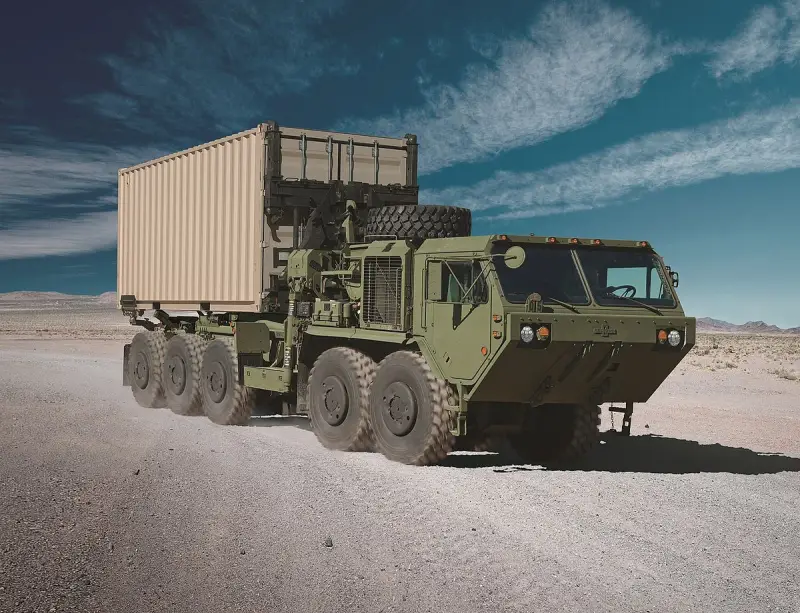 A standardized platform, a cargo container, a special gripper for quick loading and removal from the vehicle, and an armored cabin on an off-road chassis - all this can be produced by the domestic industry, but is not produced.
A standardized platform, a cargo container, a special gripper for quick loading and removal from the vehicle, and an armored cabin on an off-road chassis - all this can be produced by the domestic industry, but is not produced.One of the problems that clearly emerged during the Northern Military District is the state of affairs with logistics in the RF Armed Forces, especially with the logistics of ammunition for artillery.
Western publications wrote that the transport capabilities of the RF Armed Forces were insufficient even before the Northern Military District; as an example, we can recall the article by US Army Lieutenant Colonel Alex Vershinin Feeding the Bear: A Closer Look at Russian Army Logistics and the Fait Accompli
But Vershinin is relying on an insufficient fleet of trucks, while the logistics problems of the Russian Armed Forces go far beyond the number of rolling stock and drivers. In fact, the organization of transportation in our Army is not far from the forties of the last century.
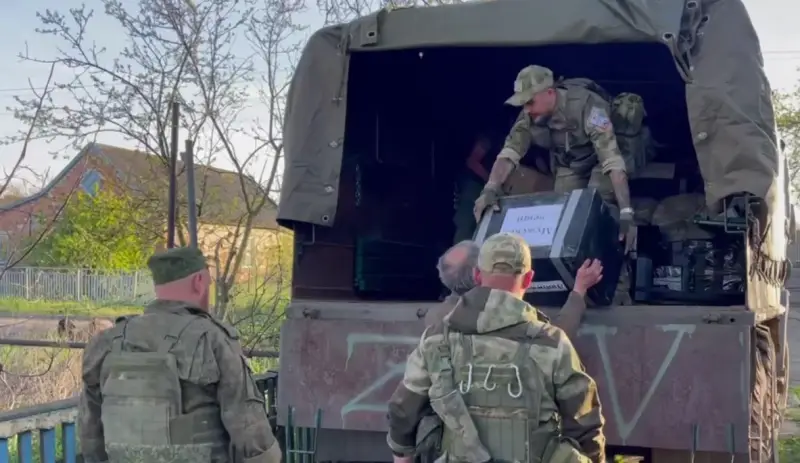 This picture can be seen in any army in the world, but in our country almost everything is built on this approach. Photo by Vesti-Yamal.
This picture can be seen in any army in the world, but in our country almost everything is built on this approach. Photo by Vesti-Yamal.In our Army, until very recently, cargo transportation had the following characteristic features:
– constant re-grading in warehouses, both food, fuel and lubricants and RAV (this is why cumulative ones can be submitted instead of PF, etc., and this is not something out of the ordinary);
– manual loading and unloading by personnel;
– extremely low, and most often absent, mechanization of loading and unloading operations;
– use of containerized cargo without pallets;
– inability to use container transportation and non-use of containers;
– organizing the storage of goods in warehouses of varying degrees of centralization, often quite large, located tens of kilometers from the line of combat contact (LCC).
The size of the warehouses, the required number of personnel for loading and unloading operations and the movement of trucks gave enemy intelligence the location of these warehouses, and with the appearance of the M142 HIMARS MLRS in the Armed Forces of Ukraine, high-precision strikes immediately began to be carried out on artillery ammunition warehouses.
The result was the famous “shell famine” of 2022, although it was not only a matter of strikes...
The Russian approach makes supplying troops on the front lines extremely difficult. Unloading the vehicle alone either requires a mass of soldiers and more than ten minutes of time, or, with a small number of personnel, a long parking period of tens of minutes; the lack of methods for managing large reserves makes centralization inevitable, and the latter - enemy attacks on warehouses.
Disguise and dispersal of warehouse stocks solve the problem only partly. Below, a satellite photo taken by an American radar reconnaissance satellite, shows that even faint traces on the ground are detected from low-Earth orbit, and if there is a warehouse in one place or another, for example, ammunition, the traces will be visible much better, and it will not be possible to get rid of them.
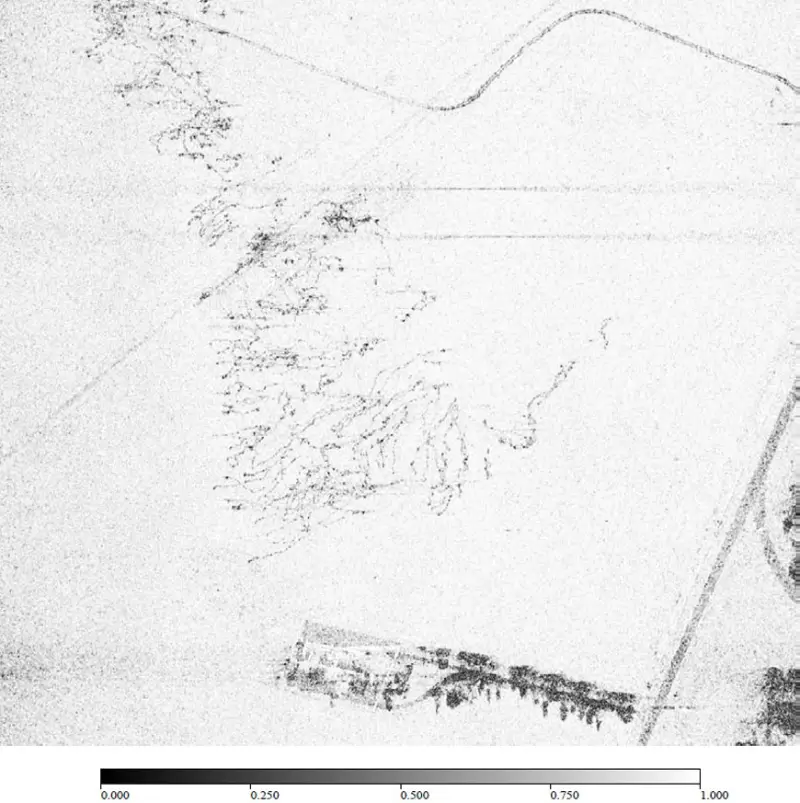 Photo: “Ravil”/aftershock.news
Photo: “Ravil”/aftershock.newsAt the moment, the problem of centralization has been partially solved - at least, warehouses have begun to be dispersed and moved further from the LBS (which, if the enemy has missiles with a range of hundreds of kilometers, still does not guarantee anything). But only partially, the army cannot yet establish reliable supplies without target warehouses, and the resulting problems on the battlefield have not gone away.
The problem of a low degree of mechanization has not been solved, although individual samples of some types of equipment (for example, trucks with crane-manipulator installations) have been developed and accepted for supplying troops, but there are very few of them; they are still based on manual loading and unloading, often in conditions of shortage personnel.
The army does not know how to work with container transportation, nor does it know how to use pallets correctly; basically everything is transported in containers - in boxes, barrels, etc.
It should also be noted that the rear staff do not have modern methods and tools for managing the movement of supplies, which makes their delivery time-consuming, and makes it impossible for the troops to receive everything they need on time in the requested quantities.
The last specific problem of the North Military District was the shortage of personnel - there are not enough soldiers of all specialties, and this also applies to drivers. On the other hand, every person who gets on the car is minus one infantryman, who are in the greatest shortage for obvious reasons.
Thus, in addition to the above problems, there is another one - with a high demand for troops for transportation, it is necessary to reduce the number of personnel involved in them.
Here I would directly pose the question: is it possible to radically change logistics? Is there a way to radically increase its effectiveness by several times and what is needed for this? Instead of trying to achieve any changes by using tools/crutches to achieve small but quick results?
The article will answer this question.
Frontline logistics deserves special attention, that is, transportation in close proximity to the line of combat contact, including the delivery of ammunition to the front line and the removal of the wounded from it.
It cannot be said that the command of the Russian troops did nothing in this direction, but the measures taken to improve the situation, even now, almost two years after Russia’s open entry into the Northern Military District, are insufficient.
It makes sense to briefly list the measures that would improve the situation, both organizational and purely technical.
Logistics management and container transportation
The benefits of introducing container shipping are described very briefly but clearly here.
In relation to the Northern Military District in Ukraine, the introduction of targeted container transportation also significantly facilitates the delivery of volunteer humanitarian aid - in some cases (this is not always advisable, but sometimes necessary), “humanitarian aid” can be included in the consolidated cargo sent to a particular military unit or unit , moreover, the picking of the cargo and its loading into the container can be done even on Sakhalin, after which it is simply transported to the place.
Difficulties in introducing container transportation into the army are:
– administrative unwillingness of the army rear to massively and widely use this type of transportation;
– lack of experience, personnel and software for the mass introduction of such transportation;
– lack of a container circulation system (they are returnable containers);
– lack of necessary loading and unloading equipment.
At first glance, the introduction of container transportation among the troops will require a huge amount of organizational work, but in fact this is not entirely true.
Since the late 2010s, all the necessary competencies have been developed and used by such a “daughter” of the Ministry of Defense as "Oboronlogistics". Here it is worth noting the author’s personal experience - in matters of international transportation, it was the Oboronlogistics employees who at one time showed the highest level of work, in comparison with other operators on the market.
“Oboronlogistics” was created at one time mainly to supply the Syrian army, and then the grouping of our troops in this country. This structure was created under the patronage of the DTO - the Department of Transport Support of the Ministry of Defense. Initially, the ATO failed to supply Syria, and the Navy had to get involved; this period is well written about in the article “The Russian Navy against the USA and the West. Example from recent operations", and transport aviation VKS, which caused enormous damage to it, which is mentioned briefly here in this article.
But later the situation was corrected, and now it is Oboronlogistics that handles almost the entire volume of transportation, except for urgent ones. Moreover, “sanctioned” types of transportation, such as ferry lines with the Kaliningrad region, for example, are assigned to this structure.
This structure has sufficient personnel potential for the Ministry of Defense to reorganize rear logistics in the Armed Forces, and the fact that almost two years after the start of the SVO this has not yet been done has no rational explanation. At all.
Which, however, is more the norm for the Ministry of Defense than the exception.
Solving the issue from the organizational side will allow you to place an order for all the necessary equipment, and here it makes sense to take a look at what to transport containers with.
A little about container ships and loading and unloading operations
Traditionally, the Russian Army has gravitated and gravitates towards rail transportation, but this type of transportation, capable of ensuring the rapid transportation of large masses of troops or volumes of cargo on the ground, is bad in all other respects - the requirements of modern warfare require such flexible logistics capabilities that they simply cannot be provided by railways. roads, in addition, it is impossible to conduct military operations with such a strict connection to the railways.
Interestingly, in the domestic economy, rail transportation has long been firmly supplanted by road transportation.
The entire logistics of the Armed Forces of Ukraine is built on cars - and we are now experiencing how effective it turned out to be.
NATO and the United States also base their logistics on road transport, that is, their experience speaks of the same thing.
The need to transfer a significant part of transportation to motor transport makes the 20-foot sea container the main type of container in the military. A container of this size can fit on a single vehicle, whereas a 40-foot container requires a tractor-trailer vehicle.
The latter excludes the use of self-loading devices and requires a container or truck crane, or even a special machine – a reach stacker – to remove the container.
Again, in some cases, large containers and reachstackers will be needed, but this will only be in the deep rear, as they approach combat zones, the containers will have to “shrink.”
In some cases, 5-foot containers will also find their use. But the basis will be a 20-foot container in a closed top version (there are open top containers - open top, and platforms without walls - flat rack).
At the same time, we should not forget that the container form factor can contain both bulk containers and equipment, that is, this is a universal standard.
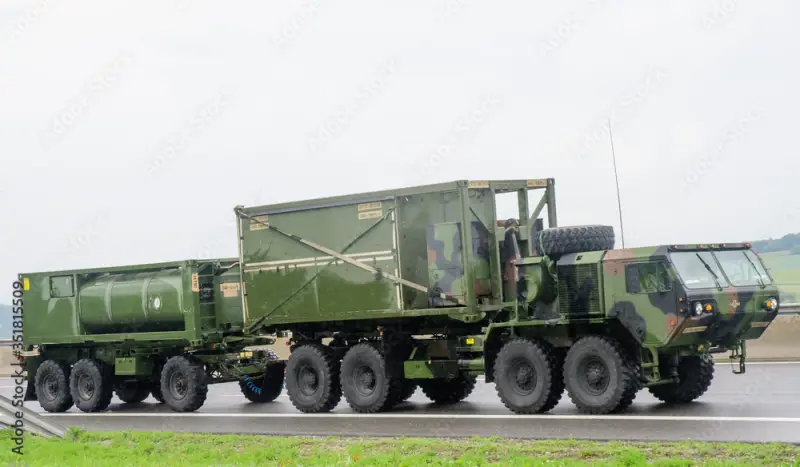
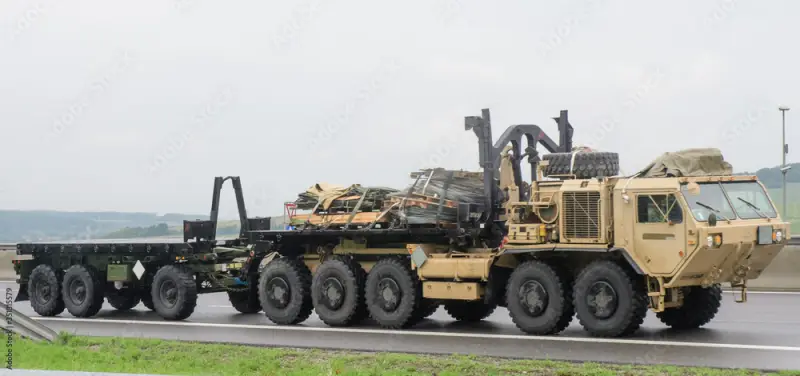 Example of standardized loads compatible with a 20ft container
Example of standardized loads compatible with a 20ft containerWhat is most important is that when switching to such a form factor, it becomes possible to create a universal transport vehicle capable of taking on a significant part of the logistics tasks.
An example of such technology is the American Palletized Load system - PLS, a standard of the American army since 1993.
A special self-loader vehicle (in the civilian sector, such equipment is called a “multilift” or “hook loader”) has a set of grippers and a transport platform that allows you to load both 20-foot containers and any cargo laid and secured on standard pallets (pallet – pallet, hence the name of the system), see illustrations.
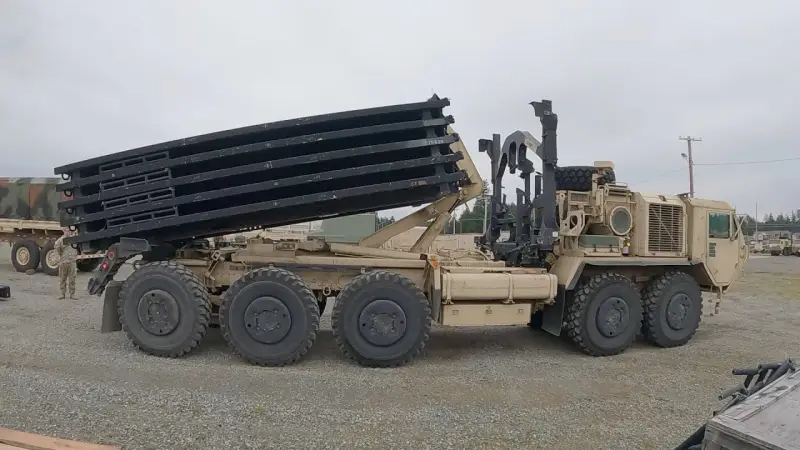
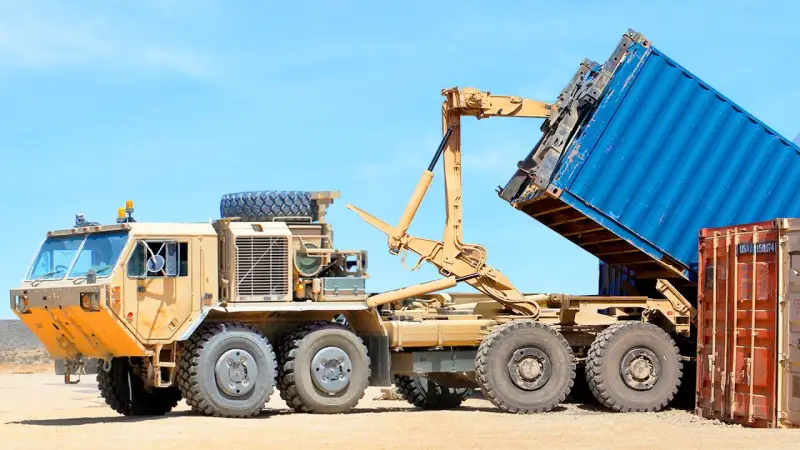
And the advantage of such a machine is immediately obvious - it simply dumps the container at the unloading point, picks up the empty one and leaves - no crowd of soldiers carrying boxes in their arms near a standing truck. There is no such crowd of soldiers even later, when the container itself is being unloaded.
Depending on the load-bearing capacity of the soil at the unloading site, either an ordinary forklift or a special version of an all-terrain forklift is used.
Naturally, all the cargo in the container is packaged on pallets that can be lifted by a forklift.
Recently, so-called telescopic loaders have become popular - machines whose “forks” are mounted on a telescopic boom. Their advantage is that they can load pallets to a great height, which allows, among other things, to equip an unloading point in deep pits or underground structures and pull the pallets to ground level without a crane. In most cases, this machine also replaces a conventional loader.
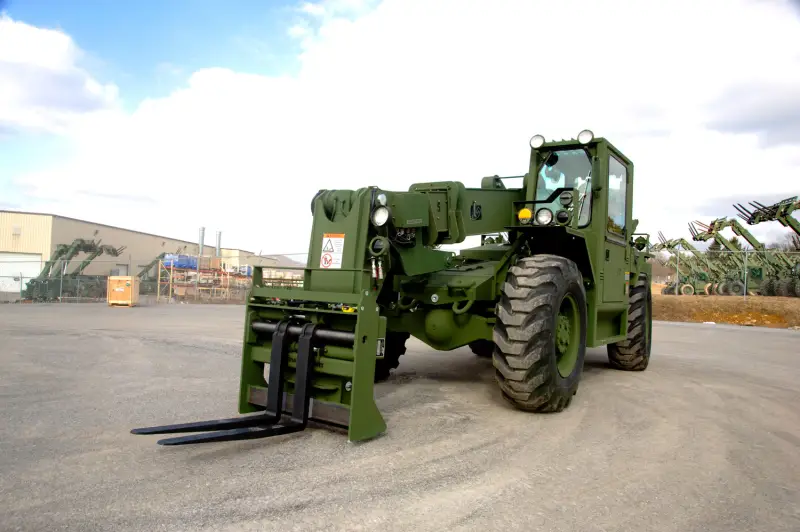 An American telescopic loader, similar ones can be seen in the background, with the boom raised. NATO has both armored options and vehicles that can drive into a container and be transported in it.
An American telescopic loader, similar ones can be seen in the background, with the boom raised. NATO has both armored options and vehicles that can drive into a container and be transported in it.A pallet with cargo can be placed on a regular truck equipped with a crane and only then sent closer to the front line.
But purely container traffic should also be in demand and applicable in supplying troops on the LBS. Let's give an example of such a supply chain.
At brigade warehouses, cargo for the unit is formed, let’s say, into a dumpable container with a 6 cubic meter body. At the “conditionally safe point” closest to the LBS (there are no others), at a distance of 1–2,5 km from the positions, by the set time, the container is dropped within 2 minutes, camouflaged with an integrated camouflage kit for 5 minutes. It turns out to be a temporary warehouse.
The car is sent for the next loading or picking up another already processed container body (loading of which takes 2 minutes by a crew of two people).
The container is “processed”: unloaded by the receiving unit at a suitable pace with optimal use of resources at a comfortable time and at a convenient time, and not amid shouts of “Hey, come on! Let's! Let's! Otherwise they’ll throw it on you now! And here is a car and ten people!”
The machine can arrive to load the processed container body at any convenient time (hour, day, week). At the same time, the loading points can be maneuvered very widely, the requirements for the discharge site are minimal.
There are only growing demands to prevent misgrading or shipment of low-quality cargo (for example, spoiled products).
One-way delivery, wooden pallets and the importance of cranes
In the commercial sector, an onboard truck with a crane-manipulator is one of the most popular types of vehicles. Such vehicles have been developed and accepted for supply for the RF Armed Forces, but are purchased from the RF Armed Forces in insufficient quantities.
 KMV-10K vehicle with a hydraulic crane-manipulator installation. It was adopted for supply many years ago, but is available in trace quantities to the troops. Photo: Vitaly Kuzmin
KMV-10K vehicle with a hydraulic crane-manipulator installation. It was adopted for supply many years ago, but is available in trace quantities to the troops. Photo: Vitaly KuzminThere are various types of crane-manipulator units (CMU), for example, cable-type ones have long booms, even small buildings can be built with them, and hydraulic ones do not have a cable system and a winch; a hook or other load-handling mechanism is rigidly fixed at the end of the boom, the reach of the booms of such cranes -manipulators are much smaller than cable ones, but the load capacity is significantly higher.
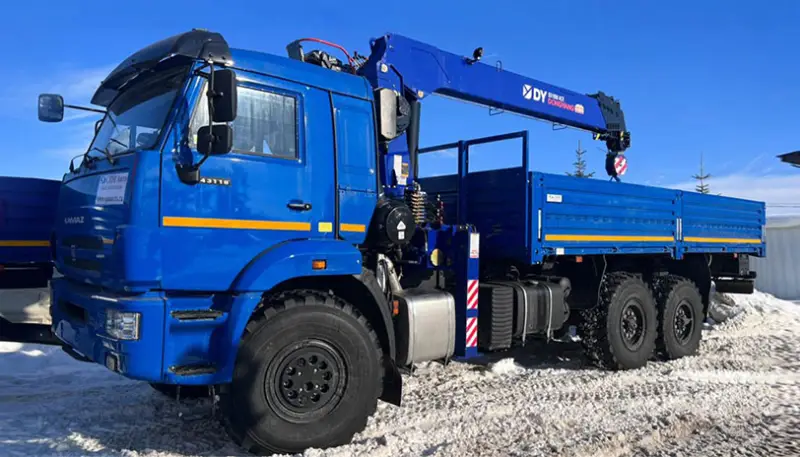 And this is one of the main workhorses in the North and one of the most popular domestically produced trucks - the “civilian” KAMAZ-43118 with a DongYang cable-operated CMU. In war, a cable crane could unload a pallet 10–15 meters from the track, into bushes or planted under tree crowns. Photo: Korib LLC
And this is one of the main workhorses in the North and one of the most popular domestically produced trucks - the “civilian” KAMAZ-43118 with a DongYang cable-operated CMU. In war, a cable crane could unload a pallet 10–15 meters from the track, into bushes or planted under tree crowns. Photo: Korib LLCHydraulic manipulators can be placed either behind the truck cab or on its rear overhang. The latter method does not worsen cross-country ability (the CMU behind the cabin loads the front axle, increasing the pressure on the ground), but it prevents the transportation of personnel on the vehicle, since the vehicle loses the tailgate on the side platform.
Hydraulic crane manipulators can be used in conjunction with a sliding awning.
In general, this is a well-known technique in the RF Armed Forces, but, we repeat, it is not enough.
What do such machines provide in terms of logistics?
If the use of standard wooden pallets is established, then you can throw the cargo packed on them closer to the front line, where enemy reconnaissance will no longer allow holding the transport for a long time. Cargo on a pallet is already a fairly small scale for a company or platoon; everything that the platoon or company needs right now can be packed there, and after packaging, the pallet can be wrapped in a mask net at the loading point, so that while it is not unloaded , it would not be noticeable when observed from drone.
A machine with a crane can deliver 6-8 pallets with a load on each, dump them at specified points and leave without stopping in the danger zone. This delivery method is beneficial, for example, for artillery.
There is no need to invent anything new for this, but the Ministry of Defense has not even mastered the supply of mask networks... however, our logistics officers also do not know how to work with pallets.
And here again it is worth turning your attention to the pernicious West. If a standard pallet is used “under the forks”, then the cargo itself - shells, missiles of various types, etc., have very different types of packaging, containers, etc., but all of them, without exception, are made so as to be compatible with standard pallets, and therefore with forklifts.
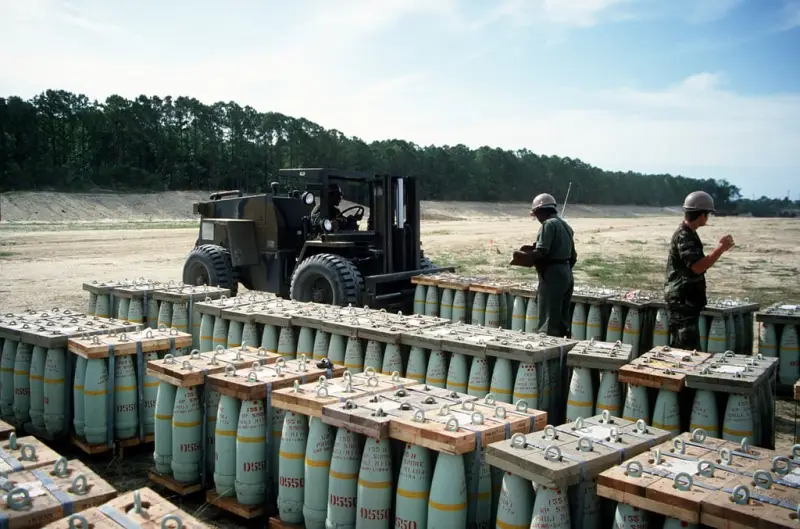 American soldiers load shells. Standardized stacks, two per standard pallet, can be lifted with a forklift, can be lifted by eye-loops with a hook, and yes, an all-terrain forklift is available. This is 1983, but for us this is an unattainable level even 40 years later. Photo: US National Archives
American soldiers load shells. Standardized stacks, two per standard pallet, can be lifted with a forklift, can be lifted by eye-loops with a hook, and yes, an all-terrain forklift is available. This is 1983, but for us this is an unattainable level even 40 years later. Photo: US National ArchivesThe result is simple - to load a large three-axle truck with artillery shells, Westerners need at least one person and 20 minutes of time, to transfer the pallet from the vehicle to the ground using a CMU - one person and 5 minutes.
Anyone who has encountered such work in our Army can compare...
 And this is Ukraine, loading the Javelin ATGM into the KrAZ Ukrainian Armed Forces. We pay attention to how the tubes with rockets are packed, how the packaging dimensions are combined with a standard wooden pallet. This is a system, and it is there in everything. Photo: CNN
And this is Ukraine, loading the Javelin ATGM into the KrAZ Ukrainian Armed Forces. We pay attention to how the tubes with rockets are packed, how the packaging dimensions are combined with a standard wooden pallet. This is a system, and it is there in everything. Photo: CNNThe last part of the logistics chain “from the rear to the front line” is the delivery of goods directly to the line of combat contact, to the infantry.
In conditions of massive enemy use of FPV strikesdrones, this is extremely difficult to do on vehicles.
The solution to the problem is the so-called “leading edge conveyor”, and this was described in detail in the article “The Army needs frontline transporters—and fast.”
It is at this stage that an unmanned vehicle is urgently needed - to transport a small shipment from an abandoned container or pallet to military positions.
Here we must give the Ministry of Defense its due - for solving such (and not only such) problems Chinese small-sized transporters were purchased. Another thing is that this, it seems, is not enough, and the machine, with all its advantages, is not optimal, something else is needed.
Nevertheless, this is exactly the case when there is no fish and no fish, and we must continue these purchases, saturating the Army with small-sized transport. This in no way eliminates the need to develop normal transporters.
True, without bringing the entire army logistics system into an efficient state, the effect of these transporters will be minimal; a systematic approach is needed.
Without drivers
The last thing to note in relation to logistics is the need to introduce unmanned vehicles as quickly as possible. And we’re not just talking about TPK.
Here it must be said that the domestic industry has serious developments on this topic.
Thus, KAMAZ has been working on an autonomous truck since at least the beginning of the 2010s. Here is an article from Komsomolskaya Pravda dated October 27, 2015 - "KAMAZ" drone drove five thousand kilometers without a driver".
And here’s also about an unmanned KAMAZ, already from 2022:
Link
This program is actually very old, KamAZ trucks without drivers have been distinguishing road signs for a long time, they drove along Arctic winter roads, they were tested in Kazan Innopolis, on public roads, and now in the industrial jungle (those who have seen it will understand) MMK. That is, the technology is relatively mature.
Not long ago, URALAZ showed a similar truck.
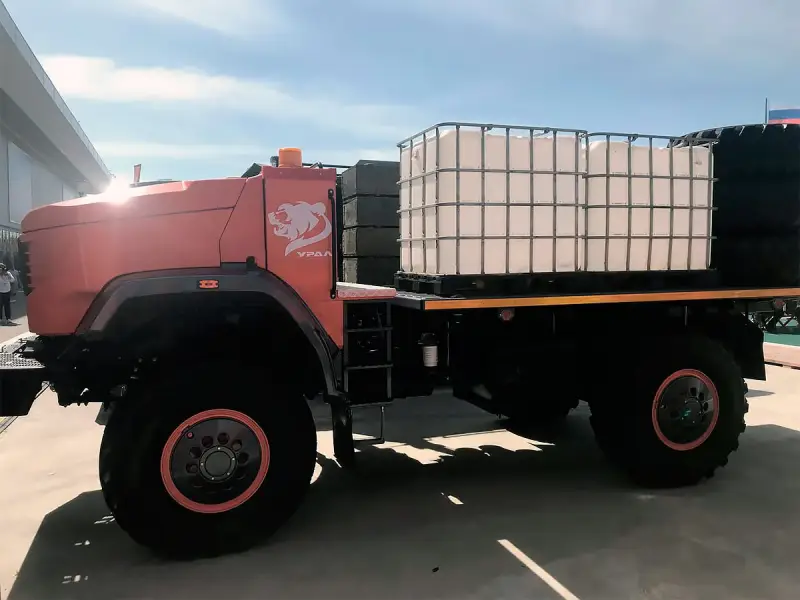 Prototype or layout of an unmanned Ural
Prototype or layout of an unmanned UralIt is still unclear how it is doing with the tests, unlike KamAZ, whose experiments have been in plain sight for many years, the Ural has not been heard of in this field before, but, on the other hand, there has long been nothing exclusive in an unmanned vehicle, in that The US Marine Corps has driverless combat vehicles already in service.
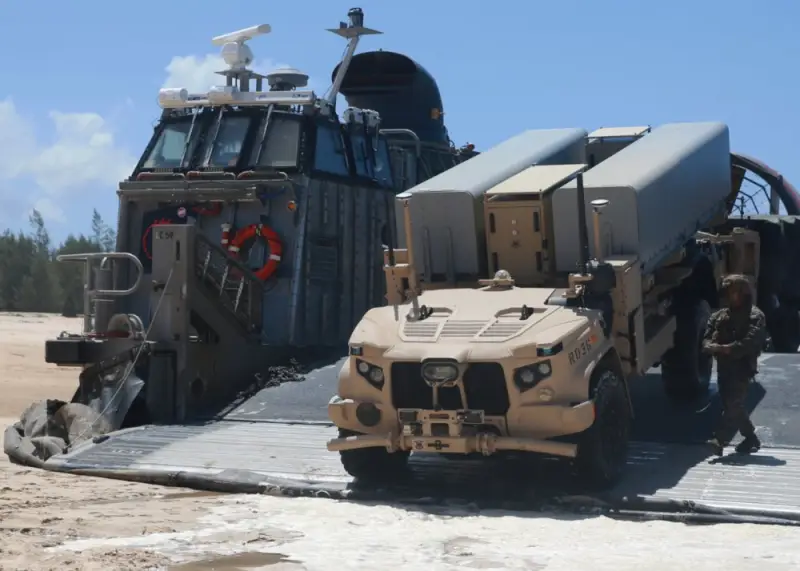 US Marine Corps anti-ship missile launcher on an unmanned chassis during an exercise
US Marine Corps anti-ship missile launcher on an unmanned chassis during an exerciseThus, even if not quickly, it is time to start releasing personnel in the field of military transport now; the domestic industry has experience for this.
And not only for this.
Technical background
As mentioned above, domestic industry can quickly create everything necessary; moreover, some equipment is already being supplied to the troops.
For example, the KMV-10V crane-manipulator was accepted for supply back in 2016.
Serious automakers have ready-made lines of vehicles with crane manipulators applicable in the military sphere, and hundreds of small companies specialize in installing ready-made crane installations on automobile chassis; examples can be found in the article "New horizons for military cranes".
The installations themselves are produced in the Russian Federation, and if there is a shortage of them, cable CMUs can be purchased in China. So far, hydraulic European installations from Fassi, Ferrari, etc., as well as South Korean cable installations Kanglim, Dongyang, Soosan and Japanese Tadano are available. In general, there are no technical problems with the supply of such equipment.
The production of wooden pallets and special packaging and crates for military equipment compatible with pallets is also not a problem.
More complex self-loaders also exist, albeit in small quantities. For example, we can name the ML-10 self-loader vehicle on an eight-wheel KamAZ 6350 chassis.
Here, a flaw is striking compared to the West - the machine unloads its own on-board platform as a unit of reusable packaging, and not a standard pallet for any cargo, like PLS, and not a container, which are not used by the troops.
But this is a case where it won’t take long to remake it - technically the machines are similar, the superstructures are similar, and the next generation of self-loaders may well be containerized.
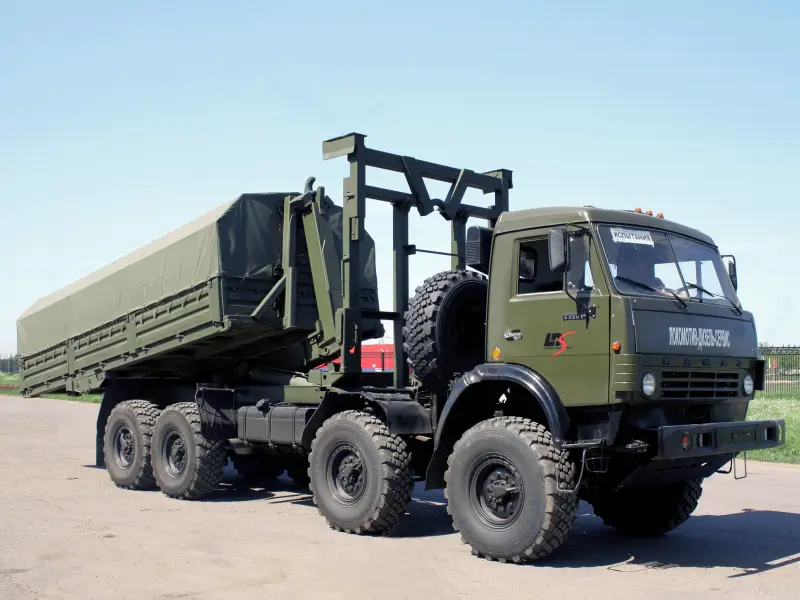
We have also developed armored cabins, like in NATO, although again in insufficient quantities, which has also entailed a lot of unnecessary losses, but it can be done.
There are also developments in robotic TPKs, such as Robot-transporter “Marker”, and the number of small companies capable of making a transporter with a driver is in the dozens.
To work in “large” warehouses with 40-foot containers, there are semi-trailers and domestic tractors, there are truck-mounted and stationary cranes, there are not only reach stackers, but they can be imported.
While forklifts for outdoor loading operations are manufactured domestically, small warehouse forklifts, rough terrain forklifts or telehandlers can be imported from China.
Logistics software can even be used commercially, is also uncomplicated and can be custom developed very quickly.
In general, we are solving the issue of technical equipment, and very quickly, it’s just a matter of using the available capabilities properly. In what our Ministry of Defense, alas, is traditionally weak.
However, there is a “fast” option here too.
We need a “transport” PMC
In developed countries (and from the point of view of the ability to organize military actions, Russia, alas, is not one of them) there is such an instrument as private military companies, PMCs. Domestic leaders understand this instrument in a very perverted way, as a kind of quasi-army. In reality, the purpose of such structures is completely different.
Here it makes sense to cite as an example one of the author’s articles on the topic, "Non-state contracting for war." in the magazine "Arsenal of the Fatherland". Quote from there:
At the same time, most PMCs in the world have a completely different purpose. The goal of their employers is usually not to get a private “backup” of the state’s armed forces, but to, with the help of a non-state contractor, close the “weak points” of their military machine, without resorting to long and complex bureaucratic approvals and the formation of various highly specialized units, which are then not will be in demand. Actually, this was the typical role of “private traders”.
In fact, we are talking about a simple transaction: money in exchange for providing the missing opportunities and time. In other words: the state pays to quickly get what it does not have right now, and which cannot be created by legal means within state structures.
For example, the armed forces lack motorized troops. You can begin to form motor battalions and motor transport delivery regiments, recruit or call up soldiers, create a basing infrastructure for them, purchase trucks and fuels and lubricants. Or you can hire a private “office” that will handle logistics. And it doesn’t matter how and at what cost she will do this work.”
Let's look at the situation again. There is the Ministry of Defense, which is mentally stuck in 1940 in terms of logistics.
And there is a “daughter” of the Ministry of Defense “Oboronlogistics”, where everything is more or less at the modern level, where there are full-fledged approaches to work, where they know how to work with containers, where there is software, personnel, etc.
What prevents us from “merging” the availability of such personnel and approaches to work with the capabilities of both our and Chinese industry to supply the necessary equipment and organizing a logistics structure that would work out all the necessary working algorithms, staffing levels, standards for the provision of equipment and supplies, containers, pallets etc.?
What prevents you from simply scaling them to the entire army later, when all these things have been worked out?
Lack of will and understanding of how to act.
But if such problems arise, solving problems with logistics in the RF Armed Forces will be quite possible, moreover, according to some external signs, at least the General Staff has begun to recognize the problem.
PMCs as a tool are the most preferable here, because they allow you to attract personnel from the “citizen” and avoid the monstrous bureaucracy that accompanies any government undertaking.
If there was a law allowing PMCs to operate, such a structure could even be created with private money, but such a thing in our country is now impossible to even dream of.
We won’t, but everything else is quite real.
A system that will be built on a combination of container transportation in the rear, delivery of cargo on pallets to the near rear or to ammunition supply points for equipment, and on small-sized vehicles directly to the LBS, can be created in our troops as early as this year - if it is created.
We can only hope that at least in the third year of the SVO, some measures will begin to be taken to correct the situation.
It's time to return from the forties of the 20th century back to the 21st century.
Information